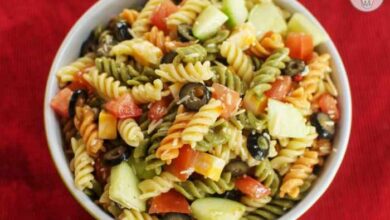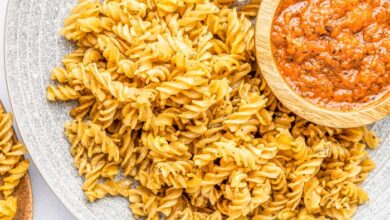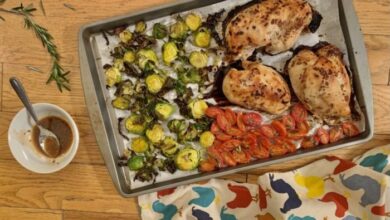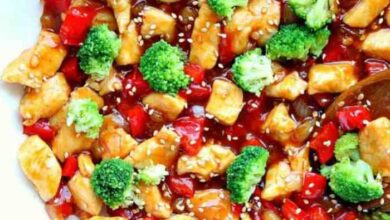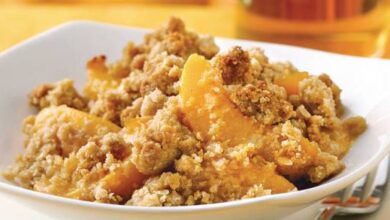
Slow Cooker Baby Back Ribs: Tender, Flavorful, and Easy
Slow cooker baby back ribs are a culinary masterpiece, offering succulent, fall-off-the-bone tenderness and rich, smoky flavors. The slow cooker does all the work, transforming tough ribs into a delectable feast. Imagine the aroma of slow-cooked ribs filling your home, the anticipation building with every passing hour.
This dish is a crowd-pleaser, perfect for family gatherings, potlucks, or simply a relaxing weeknight dinner.
The magic of slow cooking lies in its ability to break down tough connective tissues, yielding incredibly tender meat. The slow, gentle heat allows the flavors to meld and deepen, creating a symphony of tastes. Plus, the hands-off nature of the slow cooker makes it ideal for busy schedules.
You can simply toss the ingredients in, set the timer, and let the slow cooker do its magic.
Introduction to Slow Cooker Baby Back Ribs
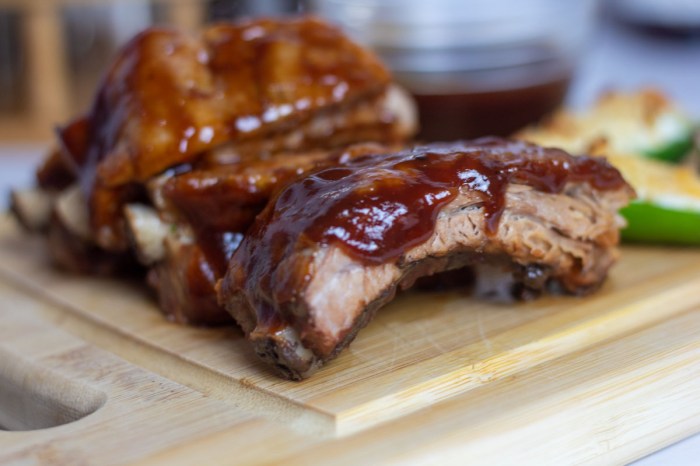
Slow cooker baby back ribs are a classic comfort food that is both delicious and easy to make. The slow cooking process allows the ribs to become incredibly tender and flavorful, making them a crowd-pleasing dish for any occasion.
Slow cooker baby back ribs are a classic comfort food, and they’re perfect for a casual weeknight dinner or a weekend gathering. But what about a delicious side dish to complement those ribs? I recently discovered a recipe for stuffed air fryer potatoes that’s both flavorful and easy to make.
The crispy potatoes are the perfect contrast to the tender ribs, and the whole meal comes together in a snap! Next time you’re planning a rib feast, don’t forget to add these amazing potatoes to your menu.
The History and Origins of Slow Cooker Baby Back Ribs
While the exact origins of slow cooker baby back ribs are unclear, the practice of slow cooking meat dates back centuries. Early methods involved using a low and slow fire over an extended period, often using a Dutch oven or a pit dug in the ground.
This technique was particularly popular in regions where wood was readily available, such as the American South and the Caribbean. The development of the slow cooker, a modern appliance that allows for low-temperature cooking without constant monitoring, revolutionized the way ribs were prepared.
The slow cooker’s ability to maintain a consistent low temperature over several hours, creates the perfect environment for tenderizing and flavoring the ribs.
The Benefits of Slow Cooking Baby Back Ribs
Slow cooking offers several advantages when preparing baby back ribs.
Slow cooker baby back ribs are a classic comfort food, and while they simmer away, I’m always looking for a light and refreshing dessert to pair with them. This year, I’m trying a german rhubarb meringue cake recipe I found online.
The tartness of the rhubarb is the perfect counterpoint to the rich, smoky ribs, and the meringue adds a touch of sweetness and airiness to the meal.
Advantages of Slow Cooking
- Tenderness:The long, slow cooking process breaks down the connective tissues in the ribs, resulting in exceptionally tender meat that practically falls off the bone.
- Flavor Development:The slow cooking process allows the flavors of the ribs to meld and intensify, creating a rich and complex taste profile.
- Convenience:Slow cookers are incredibly convenient, allowing you to prepare the ribs and leave them unattended for hours. This is perfect for busy schedules or when you want to enjoy a hands-off approach to cooking.
- Moisture Retention:The slow cooker’s sealed environment helps retain moisture, preventing the ribs from drying out during the long cooking process.
Ingredients and Preparation
Getting started with slow cooker baby back ribs is easy, and the process involves gathering the right ingredients and prepping the ribs for the slow cooker. Here’s what you’ll need and how to prepare the ribs for the perfect slow-cooked experience.
Essential Ingredients
The essential ingredients for making slow cooker baby back ribs include:
- Baby Back Ribs:The star of the show! Choose a rack of baby back ribs that has a good amount of meat and marbling for maximum flavor and tenderness.
- Dry Rub:A dry rub is a blend of spices that adds depth and complexity to the flavor of the ribs. Common dry rub ingredients include paprika, brown sugar, garlic powder, onion powder, salt, black pepper, and chili powder. You can use a pre-made dry rub or create your own.
- Liquid:A liquid is essential for creating a moist and flavorful environment in the slow cooker. Popular options include apple cider, beer, cola, or even water.
- Optional Ingredients:You can add optional ingredients to enhance the flavor of your ribs, such as barbecue sauce, honey, brown sugar, or even a splash of vinegar.
Preparing the Ribs
Before slow cooking, it’s crucial to prepare the ribs properly. This includes trimming excess fat and removing the membrane.
Trimming the Ribs
Trimming the ribs helps to prevent excess fat from rendering and making the ribs greasy. Use a sharp knife to trim any large chunks of fat from the ribs.
Removing the Membrane
The membrane is a thin, tough layer of tissue that covers the underside of the ribs. It’s essential to remove this membrane before cooking to ensure the ribs cook evenly and tenderize properly.To remove the membrane, use a sharp knife to make a small incision near the end of the rib rack.
Then, use your fingers or a paper towel to grab the membrane and peel it back, working your way down the entire length of the rib rack.
Slow Cooking Techniques
Slow cooking baby back ribs in a slow cooker is a foolproof method that delivers incredibly tender and flavorful results. The slow and gentle heat allows the meat to break down and become incredibly succulent, while the moist environment helps to prevent drying out.
Ideal Cooking Time and Temperature
The ideal cooking time and temperature for slow cooker baby back ribs depend on the size of the ribs and the desired level of tenderness. Generally, a low and slow approach is best, with a temperature of 250°F (120°C) for 6-8 hours or on low heat for 8-10 hours.
This slow cooking process allows the collagen in the ribs to break down into gelatin, resulting in melt-in-your-mouth tenderness.
For example, if you’re using a 3-4 pound rack of ribs, cooking on low heat for 8-10 hours should be sufficient.
The Role of Liquid in the Slow Cooker
Liquid is essential in the slow cooker for several reasons. First, it helps to create a moist cooking environment, preventing the ribs from drying out. Second, it adds flavor to the ribs as they simmer in the liquid. Finally, it helps to create a flavorful sauce that can be used to baste the ribs during cooking.
- Water:The simplest option, water helps to create a moist cooking environment without adding any additional flavor.
- Broth:Chicken or beef broth adds a savory base and enhances the flavor of the ribs.
- Beer:A light beer can add a subtle sweetness and a hint of bitterness to the ribs.
- Apple Cider:Adds a touch of sweetness and acidity, complementing the savory flavors of the ribs.
- BBQ Sauce:Adding a small amount of BBQ sauce to the liquid can create a flavorful glaze for the ribs during cooking.
Flavoring Options
The secret to truly amazing slow cooker baby back ribs lies in the flavoring. Whether you prefer a smoky, sweet, or tangy taste, there are endless possibilities to explore. From dry rubs that infuse the ribs with deep, complex flavors to sauces that add a glossy, sticky finish, the options are vast.
Let’s delve into some of the most popular and delicious flavor combinations.
Dry Rubs
Dry rubs are a crucial step in achieving flavorful ribs. They penetrate the meat, creating a flavorful crust that adds depth and complexity to the final product. Here are some popular dry rub recipes:
Classic BBQ Rub
- 2 tablespoons paprika
- 1 tablespoon brown sugar
- 1 tablespoon chili powder
- 1 tablespoon garlic powder
- 1 tablespoon onion powder
- 1 teaspoon black pepper
- 1 teaspoon salt
Spicy Rub
- 2 tablespoons paprika
- 1 tablespoon cayenne pepper
- 1 tablespoon chili powder
- 1 tablespoon garlic powder
- 1 tablespoon onion powder
- 1 teaspoon black pepper
- 1 teaspoon salt
Sweet & Smoky Rub
- 2 tablespoons brown sugar
- 1 tablespoon smoked paprika
- 1 tablespoon chili powder
- 1 tablespoon garlic powder
- 1 tablespoon onion powder
- 1 teaspoon black pepper
- 1 teaspoon salt
BBQ Sauces
BBQ sauces are the finishing touch that elevates ribs to a whole new level. They add a layer of flavor and moisture, creating a sticky, delicious glaze.Here are some popular BBQ sauce recipes:
Kansas City Style BBQ Sauce
- 1 cup ketchup
- 1/2 cup apple cider vinegar
- 1/4 cup brown sugar
- 1/4 cup molasses
- 2 tablespoons Worcestershire sauce
- 1 tablespoon mustard
- 1 teaspoon garlic powder
- 1 teaspoon onion powder
- 1 teaspoon black pepper
Carolina Style BBQ Sauce
- 1 cup vinegar
- 1/2 cup ketchup
- 1/4 cup brown sugar
- 1/4 cup water
- 2 tablespoons mustard
- 1 tablespoon chili powder
- 1 tablespoon paprika
- 1 teaspoon black pepper
- 1 teaspoon salt
Texas Style BBQ Sauce
- 1 cup ketchup
- 1/2 cup brown sugar
- 1/4 cup apple cider vinegar
- 1/4 cup water
- 2 tablespoons Worcestershire sauce
- 1 tablespoon chili powder
- 1 teaspoon garlic powder
- 1 teaspoon onion powder
- 1 teaspoon black pepper
The Importance of Seasoning and Marinating
Seasoning and marinating ribs before cooking is crucial for enhancing flavor and tenderness. * Seasoning:Dry rubs infuse the ribs with deep, complex flavors that penetrate the meat.
Marinating
Marinades tenderize the meat and add additional flavor. They can be made with a variety of ingredients, including vinegar, soy sauce, lemon juice, and herbs.By taking the time to season and marinate your ribs, you’ll ensure a truly delicious and satisfying meal.
Serving Suggestions
After hours of slow cooking, your baby back ribs are ready to be devoured. But what truly elevates this meal is the perfect pairing of side dishes and beverages. Here’s a guide to complement your ribs and create a truly memorable dining experience.
Side Dish Suggestions
A variety of side dishes can enhance the flavors of your slow cooker baby back ribs. Consider these options:
| Side Dish | Description |
|---|---|
| Macaroni and Cheese | Creamy and cheesy, this classic comfort food provides a delightful contrast to the savory ribs. |
| Coleslaw | A refreshing and crunchy side, coleslaw offers a welcome contrast to the richness of the ribs. |
| Baked Beans | Sweet and smoky baked beans are a traditional accompaniment to ribs, providing a balance of flavors. |
| Potato Salad | A creamy and tangy potato salad is a satisfying side that complements the ribs well. |
| Corn on the Cob | Grilled or roasted corn on the cob adds a touch of sweetness and a satisfying crunch. |
| Green Salad | A simple green salad with a light vinaigrette provides a refreshing and healthy counterpoint to the ribs. |
Presentation and Garnishing
Presentation is key to elevating your slow cooker baby back ribs from a simple meal to a culinary masterpiece. Here are some tips:
“A well-presented dish is more likely to be enjoyed.”
* Plating:Arrange the ribs on a platter or individual plates, ensuring they are attractively displayed.
Slow cooker baby back ribs are a real crowd-pleaser, especially when paired with a sweet and tangy side dish. I love to serve them with a fresh rhubarb bread pudding , which balances the savory ribs perfectly. The tartness of the rhubarb cuts through the richness of the ribs, creating a delicious and satisfying meal.
Plus, the slow cooker makes it so easy to prepare, leaving you free to enjoy the company of your guests!
Garnishing
Enhance the visual appeal with garnishes like fresh parsley, chopped chives, or a sprinkle of paprika.
Sauce
Serve your favorite barbecue sauce alongside the ribs, allowing guests to customize their experience.
Beverage Pairings, Slow cooker baby back ribs
The right beverage can enhance the flavors of your ribs and create a harmonious dining experience. Consider these pairings:* Beer:A crisp lager or a rich stout complements the smoky flavors of the ribs.
Wine
A full-bodied red wine, such as Cabernet Sauvignon or Zinfandel, pairs well with the richness of the ribs.
Cider
A sweet or dry cider offers a refreshing and fruity complement to the savory ribs.
Water
A simple glass of water is always a good choice, allowing the flavors of the ribs to shine through.
Variations and Substitutions
While the classic slow cooker baby back ribs recipe is delicious, there’s always room for experimentation and customization. This section explores alternative ingredients, meat substitutions, and tips for adapting the recipe to accommodate dietary restrictions.
Alternative Ingredients
- Flavoring Options:Explore different spice blends and rubs for a unique taste. Try adding smoky paprika, chipotle powder, or a blend of herbs like rosemary and thyme.
- Liquid Variations:Instead of using just apple cider, experiment with other liquids like beer, cola, or even a mix of fruit juices.
- Vegetable Additions:Incorporate chopped onions, carrots, or celery to the slow cooker for added flavor and texture.
Substituting Pork Ribs
- Beef Ribs:Beef short ribs are a great substitute for pork ribs, offering a rich, savory flavor. Cooking time might need adjustment based on the cut of beef.
- Chicken:For a lighter option, use bone-in chicken thighs or drumsticks. They will cook beautifully in the slow cooker, becoming tender and flavorful.
Adapting for Dietary Restrictions
- Gluten-Free:Ensure the spice rubs and sauces you use are gluten-free. Many commercial rubs and sauces contain gluten, so check labels carefully.
- Dairy-Free:Use dairy-free alternatives like coconut milk or almond milk in place of regular milk or cream.
- Low-Sodium:Reduce the amount of salt used in the recipe and opt for low-sodium ingredients like broth or soy sauce.
Tips and Tricks: Slow Cooker Baby Back Ribs
Mastering the art of slow cooker baby back ribs is all about patience and a few key techniques that ensure a melt-in-your-mouth result. From ensuring tender meat to addressing common cooking issues, these tips and tricks will help you create a truly satisfying rib feast.
Tender and Flavorful Ribs
- Start with the Right Cut:Baby back ribs are the most tender and flavorful choice for slow cooking. They are smaller and have more meat than spare ribs, resulting in a more succulent and satisfying experience.
- Trim the Membrane:The thin membrane on the back of the ribs can make them tough. Carefully remove it before cooking for a more tender result. This membrane, also known as the silverskin, can be easily peeled off with a sharp knife or by using a paper towel to grip and pull it away.
- Season Generously:Don’t be shy with the seasoning! Ribs benefit from a generous coating of your favorite rub, ensuring that every bite is bursting with flavor. Experiment with different spice combinations to find your perfect blend. For example, a classic combination of paprika, brown sugar, garlic powder, onion powder, and salt will create a well-rounded flavor profile.
- Slow and Low:The key to tender ribs is slow cooking on low heat. This allows the collagen in the meat to break down, resulting in fall-off-the-bone tenderness. Aim for a cooking time of 6-8 hours on low heat.
- Liquid is Key:Adding a small amount of liquid to the slow cooker helps prevent the ribs from drying out and keeps them moist. Choose a flavorful liquid like apple cider, beer, or even a combination of broth and your favorite sauce.
Troubleshooting Common Issues
- Dry Ribs:If your ribs are a bit dry, you can add more liquid to the slow cooker or try wrapping them in foil for the last hour of cooking. This will help to retain moisture and prevent them from drying out.
- Overcooked Ribs:Overcooked ribs can become tough and dry. If you suspect your ribs are overcooked, you can try shredding them and using them in a different dish, such as a BBQ sandwich or tacos.
- Uneven Cooking:To ensure even cooking, arrange the ribs in a single layer in the slow cooker, making sure they are not overlapping. This allows for even heat distribution and prevents some ribs from cooking faster than others.
Storing and Reheating
- Storing:Leftover ribs can be stored in an airtight container in the refrigerator for up to 3-4 days. You can also freeze them for up to 3 months.
- Reheating:To reheat ribs, you can place them in a preheated oven at 350°F (175°C) for 15-20 minutes, or until heated through. You can also reheat them in the microwave, but this may result in a slightly drier texture.
Visual Representation
Watching your ribs transform in the slow cooker is a culinary journey that involves both smell and sight. As the meat simmers, you’ll witness a fascinating evolution of color and texture. Understanding these visual cues will help you determine when your ribs are perfectly tender and ready to enjoy.The appearance of slow cooker baby back ribs throughout the cooking process offers valuable insights into their doneness.
Observing these visual cues will guide you towards achieving the perfect melt-in-your-mouth texture.
Rib Appearance Throughout the Cooking Process
The color of the ribs will gradually darken as they cook, transitioning from a raw pink hue to a rich, mahogany brown. This color change is a result of the Maillard reaction, a chemical process that occurs when sugars and amino acids in the meat react with heat.
- Initial Stage:The ribs will appear raw and pink, with a slight sheen.
- Mid-Cooking Stage:As the ribs cook, they will begin to turn a light brown, with some areas becoming more deeply colored.
- Final Stage:The ribs will be a deep, rich brown, with a slightly glossy surface.
The texture of the ribs will also change as they cook. Initially, the ribs will be firm and slightly tough. As they cook, the meat will become more tender and succulent, pulling away easily from the bone.
- Initial Stage:The ribs will be firm and slightly tough, with a raw texture.
- Mid-Cooking Stage:The ribs will start to soften, becoming more tender and juicy.
- Final Stage:The ribs will be incredibly tender, with the meat pulling away easily from the bone.
Visual Cues for Perfectly Cooked Ribs
Several visual cues indicate that your ribs are cooked to perfection.
- Color:The ribs should be a deep, rich brown, with a slightly glossy surface. The color should be evenly distributed throughout the ribs.
- Texture:The meat should be incredibly tender, pulling away easily from the bone. The ribs should also be juicy and flavorful.
- Bone:The bone should be exposed, and the meat should easily slide off the bone.
Visual Guide to the Cooking Process
Imagine a visual timeline of your ribs in the slow cooker:
- Hour 1:The ribs are still raw, with a pink hue and a slightly firm texture.
- Hour 2:The ribs have started to turn brown, with some areas becoming more deeply colored. The texture has softened slightly.
- Hour 3:The ribs are now a deep, rich brown, with a glossy surface. The meat is incredibly tender, pulling away easily from the bone.
- Hour 4:The ribs are cooked to perfection. The bone is exposed, and the meat slides off easily.
Remember, these are just general guidelines. The exact cooking time will vary depending on the size and thickness of your ribs, as well as the temperature of your slow cooker.

